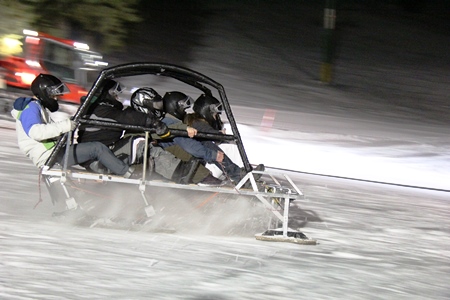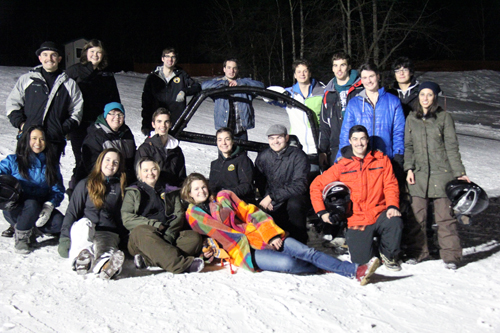
The UAlberta GNCTR team gets up to speed while taking its concrete toboggan on a test run before the national Great Northern Concrete Toboggan Race in Kelowna, B.C., Jan 21-24.
Edmonton-As defending champions, the University of Alberta 2015 Prohibition-themed toboggan team won't let anything prohibit them from aiming for the top spot again.
A team of 30 U of A students will be competing in the national Great Northern Concrete Toboggan Race (GNCTR) in Kelowna, B.C., Jan 21-24. This year's team has students from civil, petroleum, mining, mechanical, and chemical engineering, and even the School of Business.
"The team is different this year since we have 15 new people and many of them are from second and third year, which is great," said team captain, Alex May, a fifth-year civil engineering student.
There are four main designers for the toboggan with two focusing on the superstructure and two focusing on the base. The majority of the concrete toboggan is not actually made of concrete. The superstructure (top) is made of aluminum in a cage-type design to protect the riders for a fall of up to a speed of 80 km/hr. The skis are the only part of the toboggan made of concrete.
"This year we took the design of the previous years and improved upon them by using design programs. Last year our toboggan won first place so it was harder to improve it," Steven Parth, a third-year mechanical engineering student, explained.
The GNCTR involves a lot more than a downhill race, for King of the Hill. There are approximately 18 different awards up for grabs and additional corporate awards of varying monetary value. There is also a technical display portion of the competition where students can view other teams' toboggans.
"I really enjoy the technical display," May said, "I've studied concrete design for the past two years and it's interesting to see the new innovations."
The concrete used by each team is different because concrete is regional. The U of A team uses crushed porcelain from recycled toilets as its aggregate for example. The maximum weight for the toboggan is 300 pounds so an analysis is done to determine the load of the superstructure on the concrete to determine the minimum strength of the concrete and a computational flow analysis is done to minimize drag on the skis while finding the appropriate down force.
"It's not only about engineering technical knowledge, it's also about the school spirit and camaraderie. The team spirit challenge brings more fun into the competition and it's a great way to meet new people from different schools," May said.
"Our theme this year is the Prohibition because our superstructure looks like a 1920's car. For our costumes, we'll have pinstriped suites, with vests and bowler hats," Parth said.
There are 17-20 teams from different post secondary institutions across Canada at this annual event, which was began in Alberta in 1974.
"The concrete toboggan gives us hands-on experience. We don't get into our concrete labs until third or fourth year so it's great to have second-year students mixing and testing concrete," May said.
"Yeah I even learned to sew to make the costumes," Parth added with a chuckle.
"It's super easy to get involved in the concrete toboggan and what you put into it is what you get out of it. Being part of the concrete toboggan has been my No. 1 best experience at the U of A," May said.
